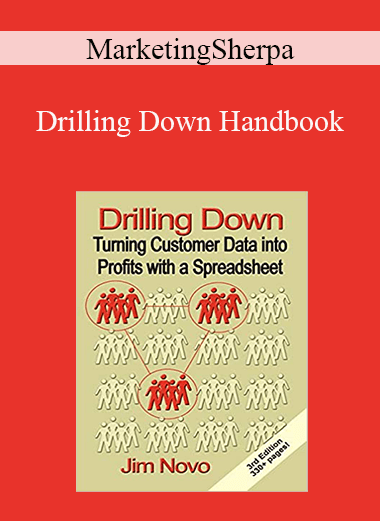Drilling Down Handbook : Turning Customer Data into Profits
Required reading for direct response marketers. Practical hands-on instructions in how to spreadsheet your customer database to find out which customers are your most valuable, and then create campaigns that make the most of this demographic.
World-Class, Action-Oriented Analytics for Ordinary Marketers Without Fancy Software Programs
Proven High ROI Customer Marketing Tips and Tricks of the Pros Revealed
Drowning in Data? Can’t figure out a way to make the data “speak to you”, to tell you something you can actually do to increase profits? You are not alone.
But the fact is there are easy to understand customer reporting techniques you can use to get your customer data to come right out and tell you where the profit opportunities are.
And none of these techniques are “black box” stuff – you don’t need any special skills or software. In fact, this approach to customer data, called behavioral analysis, has been used for decades to boil marketing data down to just the facts that really matter, so you can spend more time “doing something” to increase your ROI and less time looking at reports.
Metrics analysis guru Jim Novo, shows you how to do this yourself with nothing more complicated than some simple Excel spreadsheets. (IMPORTANT: Microsoft Access and Microsoft Excel with pivot table capability are required to run the accompanying software. Software download link is provided in Drilling Down book.)
Here is the basic idea:
1. The most important data to pay attention to is data that can directly affect the profitability of your company – now, and in the future.
2. The reports on this data most likely to increase profits are reports pointing out specific problems or opportunities – so you can take specific actions.
3. Therefore, the best reports you could ask for would be those that use data known to be the most important to increasing profits, and are in a format that will alert you when problems or opportunities to increase profits occur.
Behavioral analysis takes the data generated by the actions of your customers or business partners and transforms it into a different view of the world, a view that is both more actionable than typical reporting and also is in a format that alerts you to marketing or management problems and opportunities with the greatest potential for high ROI if you take action.
Here is the philosophy of a person using behavioral analysis as a business tool:
#1. I take action only when addressing a specific problem or opportunity has a high likelihood of being very profitable
#2. When I do take action, I always time this action for maximum ROI
If you focus your resources on actions with the highest probability of driving profits, and you time them for maximum ROI, your success rate soars and every budget dollar works harder and harder.
But how do you know which problems or opportunities have a high likelihood of being very profitable, and how do you know when to act on them?
Behavioral analysis answers both questions for you. Here’s what you can do with Drilling Down on your desk:
- Predict which marketing campaigns are going to generate the most valuable customers – before the campaigns even end.
- Emphasize the ads, media, and products creating long-term high potential value customers and downplay ones that don’t.
- Create High ROI customer marketing programs designed to increase response rates while lowering promotional costs.
- Determine when best customers are likely to leave you and react with customer retention and save-a-customer programs.
- Quantify the profitability of marketing and operational initiatives by linking them to a change in potential customer value.
But how is behavioral analysis implemented, what exactly can you do with this kind of information to increase profits? Here are some examples:
You have a limited ad budget but want to test as many approaches as possible. Starting with 10 different campaigns, you kill off 7 of them within 2 weeks, including some campaigns with high initial response rates, and you put all your money into the 3 remaining campaigns.
The boss thinks you are crazy, but 60 days later you produce a report proving new customers generated by the 3 campaigns you kept were worth 5 times as much as the average customer generated by the other 7 campaigns. The boss doesn’t know you predicted which campaigns would generate customers that buy over and over again using the behavioral metric called Recency .
Your company sells a base software product with add-on modules for different markets. Sales of the base product have been rising nicely, but sales of the add-on modules are flat. The CFO can’t figure out why this is happening and wants an answer. You come back and explain a new vertical market is causing the imbalance but not to worry about it., you will take care of it.
A month later sales of the base software and add-ons are back in alignment. The CFO thinks you are brilliant but you didn’t really do anything, you simply predicted this would happen anyway using the behavioral metric called Latency.
Sales are tough and the company is relying on your division to be the lead revenue source, but you are going to miss forecast. You need to generate some sales fast by month end, and you have a budget that will only cover promoting to 10% of your customers.
What’s more, you can’t make any special offers to anybody – no discounts, no free services. Everybody thinks you are in big trouble, but you pull it out in one week and beat forecast. The other division heads are amazed, but what they don’t know is you simply predicted which customers were most likely to buy using the behavioral model called RFM.
Distributors or agents sell your products along with competing products from other companies. Sales have been soft and there is a feeling the distributors/agents have been pushing the products of competitors harder. The President of the company wants something done but there is no additional budget to spend on the effort.
You grab the reins and tell a skeptical President you will fix this problem. A few months later, skepticism turns to amazement as sales are on the rise again, and you get a promotion for all your “hard work”. The fact is you simply focused the distributor / agent relations effort by predicting those most likely to switch to the competition using a combination of Recency and Latency.
–>Readers say:
“Drilling Down gives marketers the ability to do meaningful, effective customer value-scoring themselves, quickly and easily. I know — I used it on a time-sensitive project, and it works.”
-Lori Witzel, Marketing Manager, Sheshunoff Information Services
“Jim Novo brings customer database marketing and CRM analysis to life. He shows you the roadmap to success in a simple, straightforward way. He takes everything you wanted to know about managing customer relationships and places it in one resource.
“There is more “real world” information about customer analysis and database marketing packed into 180 pages than you could get in a year’s worth of seminars and consultant meetings. Jim gives the tools of the professionals to “everyone.”
“This book teaches you exactly how to use CRM for customer valuation and to influence retention. With a simple Excel spreadsheet you can create action-oriented customer profiles and segment LTV’s (Lifetime Total Value) for different groups you can develop different messages aimed at each group, with products and offers appropriate to the group being addressed. You end up increasing your ROI by acquiring more customers like gold customers (your best customers) and getting other customers to move up to gold.
“One of the techniques that I learned in this book that I liked the most was how to personalize a Web page based on customer behavior. I was amazed to discover that I could do this just using a spreadsheet! There are people spending hundreds of thousands of dollars for do what you can do just by reading this book!
“We can’t keep targeting our customers and blasting them with junk anymore. And we can’t keep buying loyalty with ever-deeper, loss-making discounts. Now we have to start listening to our individual customers’ needs, and find cost effective ways of meeting and influencing them. This book is a must read for those who wish to survive and prosper in this cutthroat web economy. Get this book!”
-Leonardo Grinstein, co-CEO, PercaGordura.com / CorpoPerfeito.com, Brazil
“I am about to make a leap to a much bigger job as Marketing Manager of a large online and catalogue computer reseller, and your words are my holy grail• Armed with this knowledge, anyone can [succeed] in direct marketing, whether it be online or through an offline catalogue.”
-Luke Ashworth
“Concepts that may take companies and professionals years, huge budgets and expensive software to learn (if they ever do at all) are explained in a very simple and practical way. The whole book, and its concepts and ideas, are so clear that even non-native English speakers as myself (I am Argentinian) fully understand it and can easily put it to work in practice. Every chapter gives you powerful insight that can be applied in your business.”
-Martín Kessler, Argentina
“you seem to be one of the few with real life experience in database marketing with the skills to simply explain with pragmatic examples of how RFM and LTV should be used.”
Johnson Au-Yeung, Chief Technologist, Sutherland Group
–>Complete Table of Contents:
(NOTE: Software download link is provided in Drilling Down book.)
Chapter 1: Customer Profile Or Customer Model?
Chapter 2: Data-Driven Marketing & Service Models: Customer Value Management Basics
LATENCY METRIC TOOLKIT
Chapter 3: Trip Wire Marketing
Chapter 4: The Hair Salon Example
Chapter 5: The B2B Software Example
Chapter 6: Turning Latency Data Into Profits
RECENCY METRIC TOOLKIT
Chapter 7: Customer Value-Based Marketing
Chapter 8: The Ad Spending Example
Chapter 9: Turning Recency Data Into Profits
RFM SCORING TOOLKIT
Chapter 10: Predictive Marketing
Chapter 11: A Tweak For Interactive Customers
Chapter 12: No Customer Database? How to Set Up a Spreadsheet To Score Customers
Chapter 13: How to Score Your Customers
Chapter 14: The Commerce and Content Examples: Turning Scoring Data Into Profits
LIFECYCLE-BASED MARKETING TOOLKIT
Chapter 15: Using Customer Characteristics & Multiple Scores
Chapter 16: Customer Lifecycles: Tracking Scores Over Time
Chapter 17: Customer Scoring Grids: High Performance Life Cycle-Based Tracking
Chapter 18: Straight Talk on Lifetime Value
Chapter 19: Predicting Campaign ROI: Set Up
Chapter 20: Predicting Campaign ROI: The Model
Chapter 21: Predicting Campaign ROI: Fine Tuning
Chapter 22: Costs You Don’t Know About: Measuring True ROI in Best Customer Promotions
Chapter 23: Some Final Thoughts
Appendix: Software Download and Readme
LIST OF CHARTS AND GRAPHS
Figure 1: The Customer Value Portfolio
Figure 2: Lost Revenue from Defecting Customers
Figure 3: Average Weeks between Add-On Purchases
Figure 4: Average Weeks between Add-On Purchases
Figure 5: Average Weeks between Add-On Purchases by Add-On Salesperson
Figure 6: 180 Day / No 4th Purchase Promotion
Figure 7: Calculating the Promotional Discount
Figure 8: Calculating the Promotional Overhead
Figure 9: Calculating the Total Costs and ROI
Figure 10:Percent Purchasing After Promotion End
Figure 11: Visitors by Recency #1
Figure 12: 90-Day Revisit Index
Figure 13: Visitors by Recency #2
Figure 14: Visitor Friction by Search Phrase
Figure 15: Recency Percentage over Time
Figure 16: Financial Analysis of Campaigns: Short Term RO
Figure 17: Financial Analysis of Campaigns: Long Term ROI
Figure 18: Discount Ladder Test Segment Performance
Figure 19: Purchase Recency
Figure 20: Last Purchase Date Before Newsletter Drop
Figure 21: Discount Ladder Test Segment Performance
Figure 22: Newsletter Responders by Sign-up Recency
Figure 23: Content Groups, Ranked by Total Traffic and Recency
Figure 24: Content Groups, by Traffic, Recency, and Newsletter Conversion Rate
Figure 25: The Customer Value Portfolio
Figure 26: Percent of the Customer Base over each Hurdle by Week is Growing!
Figure 27: Sample of Aggregated Customer Records
Figure 28: Raw (Not Summary) Imported Customer Records
Figure 29: Pivot Table of Most Recent Activity Date, Sorted by Customer ID
Figure 30: Pivot Table of Total Activity, Sorted by Customer I
Figure 31: Combined Recency and Frequency Pivot Tables
Figure 32: Recency Scores Added to the Scoring Spreadsheet
Figure 33: Frequency Scores Added to the Scoring Spreadsheet
Figure 34: The Completed Scoring Spreadsheet Sorted by RF Scores
Figure 35: Average Response Rate by Recency for Recency, Quintile 5 is 40 Times More Responsive than Quintile 1
Figure 36: Average Response Rate by Frequency for Frequency, Quintile 5 is 9 Times More Responsive than Quintile 1
Figure 37: Average Response Rate by RF Score in TV Shopping Top RF Score is 700 Times More Responsive than Bottom RF Score
Figure 38: Determining the Recency Hurdle Rate
Figure 39: % Customers 30 Days Recent in Subject Area over 8 Weeks
Figure 40: Determining the Frequency Hurdle Rate
Figure 41: Determining the Frequency Hurdle Rate without Inactive Customers
Figure 42: RF Scored Customers Sorted by a Characteristic: Favorite Pet Survey
Figure 43: Visit and Purchase RF Scores in the Same Spreadsheet (Database)
Figure 44: RF Scores, Visits and Purchases of New Customer over the first 13 Weeks of Contact
Figure 45: The LifeCycle Grid
Figure 46: The Customer Value Portfolio Revisited
Figure 47: First Action Behavior in the LifeCycle Grid
Figure 48: Second Action Behavior in the LifeCycle Grid
Figure 49: Delta LifeCycle Grid Demonstrating Healthy, Growing, Profitable Business
Figure 50: Delta Grid Demonstrating Poorly Performing Busines
Figure 51: Unit Profit Analysis for LTV Calculation
Figure 52: Sales by Customer Volume
Figure 53: Sales by Customer Longevity
Figure 54: Response Rate by RF Score
Figure 55: Financial Performance of Mailing to All Customers
Figure 56: Actual Responses by RF Score
Figure 57: Financial Model using Actual RF Score Response Rates for Each Score Level
Figure 58: Effective Discount rates Need to Rise as R Score Falls to Achieve Decent Response Rates
Figure 59: Discounts Applied by RF Score Allow Calculation of Total Promotional Discount
Figure 60: Financial Model with Variable Discount
Figure 61: ROI.a
Figure 62: ROI.b
Figure 63: ROI.c
Figure 64: Measuring Subsidy Cost Using a Control Group for Behavioral Comparison
Get Download MarketingSherpa – Drilling Down Handbook at coursesblock.com today!
Delivery Method
– After your purchase, you’ll see a View your orders link which goes to the Downloads page. Here, you can download all the files associated with your order.
– Downloads are available once your payment is confirmed, we’ll also send you a download notification email separate from any transaction notification emails you receive from coursesblock.com
– Since it is a digital copy, our suggestion is to download and save it to your hard drive. In case the link is broken for any reason, please contact us and we will resend the new download link.
– If you cannot find the download link, please don’t worry about that. We will update and notify you as soon as possible at 8:00 AM – 8:00 PM (UTC 8).
Thank You For Shopping With Us!







